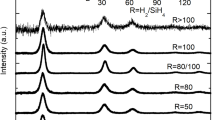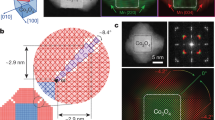Abstract
The spontaneous formation of organized nanocrystals in semiconductors has been observed1,2,3,4,5 during heteroepitaxial growth and chemical synthesis. The ability to fabricate size-controlled silicon nanocrystals encapsulated by insulating SiO2 would be of significant interest to the microelectronics industry. But reproducible manufacture of such crystals is hampered by the amorphous nature of SiO2 and the differing thermal expansion coefficients of the two materials. Previous attempts6,7,8,9,10 to fabricate Si nanocrystals failed to achieve control over their shape and crystallographic orientation, the latter property being important in systems such as Si quantum dots. Here we report the self-organization of Si nanocrystals larger than 80 Å into brick-shaped crystallites oriented along the 〈111〉 crystallographic direction. The nanocrystals are formed by the solid-phase crystallization of nanometre-thick layers of amorphous Si confined between SiO2 layers. The shape and orientation of the crystallites results in relatively narrow photoluminescence, whereas isotropic particles produce qualitatively different, broad light emission. Our results should aid the development of maskless, reproducible Si nanofabrication techniques.
This is a preview of subscription content, access via your institution
Access options
Subscribe to this journal
Receive 51 print issues and online access
$199.00 per year
only $3.90 per issue
Buy this article
- Purchase on Springer Link
- Instant access to full article PDF
Prices may be subject to local taxes which are calculated during checkout




Similar content being viewed by others
References
Yip, S. Nanocrystals—the strongest size. Nature 391, 532– 533 (1998).
Peng, X. G. et al. Shape control of CdSe nanocrystals. Nature 404, 59–61 (2000).
Empedocles, S. A., Neuhauser, R. & Bawendi, M. G. Three-dimensional orientation measurements of symmetric single chromophores using polarization microscopy. Nature 399, 126–130 (1999).
Han, W. Q., Fan, S. S., Li, Q. Q. & Hu, Y. D. Synthesis of gallium nitride nanorods through a carbon nanotube-confined reaction. Science 277, 1287–1289 ( 1997).
Budai, J. D. et al. Controlling the size, structure and orientation of semiconductor nanocrystals using metastable phase recrystallization. Nature 390, 384–386 (1997).
Baron, T., Martin, F., Mur, P., Wyon, C. & Dupuy, M. Silicon quantum dot nucleation on Si3N4, SiO2 and SiOxNy substrates for nanoelectronic devices. J. Cryst. Growth 209, 1004–1008 (2000).
Nakajima, A., Sugita, Y., Kawamura, K., Tomita, H. & Yokoyama, N. Microstructure and optical absorption properties of Si nanocrystals fabricated with low-pressure chemical-vapor deposition. J. Appl. Phys. 80, 4006–4011 (1996).
Wilson, W. L., Szajowski, P. F. & Brus, L. E. Quantum confinement in size-selected, surface oxidized silicon nanocrystals. Science 262, 1242– 1244 (1993).
Littau, K. A., Szajowski, P. F., Muller, A. J., Kortan, A. R. & Brus, L. E. A luminescent silicon nanocrystal colloid via a high-temperature aerosol reaction. J. Phys. Chem. 97, 1224–1230 ( 1993).
Shimizu-Iwayama, T., Hole, D. E. & Boyd, I. W. Mechanism of photoluminescence of Si nanocrystals in SiO2 fabricated by ion implantation: the role of interactions of nanocrystals and oxygen. J. Phys. Condens. Matt. 11 , 6595–6604 (1999).
Tsybeskov, L. et al. Nanocrystalline-silicon superlattice produced by controlled recrystallization. Appl. Phys. Lett. 72, 43–45 (1998).
Levi, D., Zhang, S.-L., Klein, M. V., Klem, J. & Morkoc, H. Raman study of the effects of annealing on folded LA and confined LO phonons in GaAs-AlAs superlattices. Phys. Rev. B 36, 8032–8037 (1987).
Lockwood, D. J., Dharma-wardana, M. W. C., Baribeau, J.-M. & Houghton, D. C. Folded acoustic phonons in Si/GexSi1-x strained superlattices. Phys. Rev. B 35, 2243– 2251 (1987).
Ivchenko, E. I. & Pikus, G. Superlattices and Other Heterostructures: Symmetry and Optical Phenomenon Vol. 110 (Springer Ser. Solid-State Science, Springer, Berlin, 1995).
Ghanbari, R. A., White, J. D., Fasol, G., Gibbings, C. J. & Tuppen, C. G. Phonon frequency for Si-Ge strained-layer superlattices calculated in a 3-dimensional model. Phys. Rev. B 42 , 7033–7041 (1990).
Mizoguchi, K. & Nakashima, S. J. Determination of crystallographic orientations in silicon films by Raman-microprobe polarization measurements. J. Appl. Phys. 65, 2583– 2590 (1989).
Haji, L., Joubert, P., Stoemenos, J. & Economou, N. A. Mode of growth and microstructure of polycrystalline silicon obtained by solid phase crystallization of an amorphous silicon film. J. Appl. Phys. 75, 3944–3952 ( 1994).
Calcott, P. D. J., Nash, K. J., Canham, L. T., Kane, M. J. & Brumhead, D. Spectroscopic identification of the luminescence mechanism of highly porous silicon. J. Lumin. 57, 257–269 ( 1993).
Cullis, A. G., Canham, L.T. & Calcott, P. D. The structural and luminescence properties of porous silicon. J. Appl. Phys. 82, 909 –965 (1997).
Cullis, A. G. & Canham, L. T. Visible light emission due to quantum size effects in highly porous crystalline silicon. Nature 353, 335–338 ( 1991).
Acknowledgements
This work is supported by US Army Research Office, National Science Foundation and Motorola. L.T. acknowledges support from the German Academic Exchange Service (DAAD).
Author information
Authors and Affiliations
Corresponding author
Rights and permissions
About this article
Cite this article
Grom, G., Lockwood, D., McCaffrey, J. et al. Ordering and self-organization in nanocrystalline silicon. Nature 407, 358–361 (2000). https://doi.org/10.1038/35030062
Received:
Accepted:
Issue Date:
DOI: https://doi.org/10.1038/35030062
This article is cited by
-
Spray pyrolysis-coated nano-clustered CdTe on amorphous Si thin films for heterojunction solar cells
Applied Nanoscience (2019)
-
Crystallization and activation of silicon by microwave rapid annealing
Applied Physics A (2016)
-
Preparation and photovoltaic properties of silicon quantum dots embedded in a dielectric matrix: a review
Journal of Materials Science: Materials in Electronics (2015)
-
Silicon crystallization in nanodot arrays organized by block copolymer lithography
Journal of Nanoparticle Research (2014)
-
Energy transfer from luminescent centers to Er3+ in erbium-doped silicon-rich oxide films
Nanoscale Research Letters (2013)
Comments
By submitting a comment you agree to abide by our Terms and Community Guidelines. If you find something abusive or that does not comply with our terms or guidelines please flag it as inappropriate.



